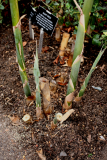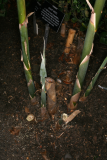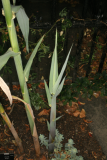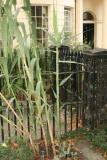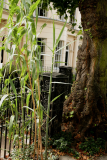Additional notes (click to expand)
Medicinal
Prescription only medicine: lignocaine
Sodium ion channel blockade; GABA transaminase inhibitor. Contains gramine, from which lidocaine and other local anaesthetics were synthesised. Also used for controlling cardiac arrhythmias.
Oakeley, Dr. H.F. (2013). Medicines from RCP plants label list 5-2013.docx.
Lignocaine was synthesised from Arundo donax, (and also Hordeum vulgare - a form without chlorophyll), which contains gramine a bitter substance. From this isogramine was made which had weak local anaesthetic properties (the researchers tasted it !). From this lidocaine (aka lignocaine) was synthesised in 1943. Note: Completely synthetic drugs amylocaine (1903) and procaine (1904) antedated these plant-derived local anaesthetics. VERSATIN lidocaine patches for post herpetic neuralgia; LIDOCAINE im/iv Ventricular arrhythmias especially after heart attack; LIDOCAINE and numerous analogues, for local anaesthesia. ** Intravenous lignocaine has been used to abolish phantom limb pain. ** Cocaine was used as a local anaesthetic before the introduction of lignocaine, and had the serious disadvantage of occasionally causing cardiac arrest, as well as the problem of dependency and psychosis.
Oakeley notes: May 2014
Extracted from: Rev. Bras. Anestesiol. vol.52 no.3 Campinas May/June 2002 *** Arundo donax - By products: lidocaine (Löfgren & Lundquist, 1943) and tryptamine (von Euler, 1929). Achiralic lidocaine was synthesized as from the methylation of a grass byproduct which, “for being so bitter, was rejected even by camels” in Asian plateaus, namely isograss (the translator should have written isogramine). Clinically evaluated in the post-war period by Gordh (1947), lidocaine has become the prototype of new non histaminergic oral anesthetics - amino-amide group – with liver metabolism and more prolonged effects 11-13. REFS: Sten L - Xylocaine (lidocaine, lignocaine), its discovery and Gordh’s contribution to its clinical use. Acta Anaesthesiol Scand, 1998;42:(Suppl113):12. REFS: Gordh T - Xylocaine, a new local analgesic. Anaesthesia, 1949;4:4. REFS: Catterall WA, Mackie K - Local Anesthetics, em: Hardman JG, Limbird LE, Gilman AG - Godman & Gilman´s The Pharmacological Basis of Therapeutics, 10th Ed, New York, McGraw-Hill, 2001;367. REFS: Holmdahl MH - Xylocain (lidocaine, lignocaine), its discovery and Gordh's contribution to its clinical use. Acta Anaesthesiol Scand, 1998;113:8-12.
Rev. Bras. Anestesiol. vol.52 no.3 Campinas May/June 2002
Arundo donax Lignocaine. Arundo donax, a fast growing reed has also been linked to the development of lignocaine but this is inappropriate. Although Russian chemists isolated gramine which they called donaxin from Arundo in Siberia, they did not realise it's possible significance for local anaesthesia. Nevertheless Dioscorides wrote 2000 years earlier that Arundo juice, applied locally soothes sprains and pains.
William Harvey and plant derived medicines currently used in cardiovascular medicine, Prof Michael de Swiet's Notes 2018
Nomenclature
Giant Reed; Spanish Reed.
Other use
Canes were used to make Pan pipes and primitive flutes by the ancient Egyptians about 3000BCE. Subsequently the flute and other simple wind instruments were developed from A donax canes during the early mediaeval period. By the mid-17th century in Europe woodwind musical instruments had been devised in which the rigidity of the cane was exploited to make the reed, as in the bassoon, oboe and even the bagpipe. Historically canes for use in musical instruments have been grown in Provence but in times of shortage those grown in the USA and elsewhere have proven satisfactory.
A. donax has been cultivated as a biofuel becuase of its rapid growth and its drought resistance has permitted its farming in drier areas. Fibres from the canes have been made into paper and textiles. It can be used for bioremediation of contamimated soils, too, as it accumulates heavy metals, such as As and Sb.
Dayan notes 2019; Perdue, 1958, Econ Bot, 12, 368.
Geographical distribution
- Africa, Northern Africa, Algeria
- Africa, Northern Africa, Egypt
- Africa, Northern Africa, Libya
- Africa, Northern Africa, Tunisia
- Asia-Temperate, Arabian Peninsula, Saudi Arabia
- Asia-Temperate, China
- Asia-Temperate, Eastern Asia, Japan
- Asia-Temperate, Eastern Asia, Taiwan
- Asia-Temperate, Middle Asia, Turkmenistan
- Asia-Temperate, Middle Asia, Uzbekistan
- Asia-Temperate, Western Asia, Afghanistan
- Asia-Temperate, Western Asia, Cyprus
- Asia-Temperate, Western Asia, Iran
- Asia-Temperate, Western Asia, Iraq
- Asia-Temperate, Western Asia, Lebanon-Syria
- Asia-Temperate, Western Asia, Turkey
- Asia-Tropical, Indian Subcontinent, India
- Asia-Tropical, Indian Subcontinent, Nepal
- Asia-Tropical, Indian Subcontinent, Pakistan
- Asia-Tropical, Indo-China, Myanmar
- Europe, Eastern Europe, Ukraine
- Northern America, Southeastern U.S.A., Georgia
Arundo donax L.
Family: POACEAEGenus: Arundo
Species: donax L.
Common names: Giant Reed; Spanish Reed
Distribution summary: Central & Southern Asia
Habit: Perennial
Hardiness: H5 - Hardy; cold winter
Garden status: Currently grown
Garden location: Classical Europe & Middle East (M)
Reason for growing: Medicinal, prescription only medicine
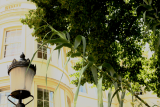
.JPG)
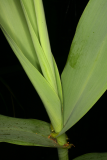


.JPG)
